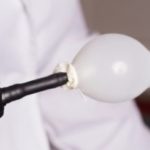Nasal Release Technique
The nasal release technique is a technique used to adjust the bones of the skull such as the sphenoid and palatine bones.

A small finger cot for nasal release technique
The procedure uses a small finger cot affixed to an inflatable device (balloon) which is gently inserted into each of the six nasal passages (three on each side), then with a hand pump the balloon is expanded. The balloon inflation presses outward against the bones lining the breathing passages and adjusts the sutures of the skull, particularly the sphenoid. This ultimately relieves the forces that have gone into the skull by releasing any impactions in the cranial sutures. Typically, It is in total 8 inflations in the nose per treatment.
This nasal release procedure is also know as — endonasal technique, cranial facial release, nasal cranial release, bilateral nasal specific technique, functional cranial release and neurocranial restructuring nasal specific technique.
The procedure can be uncomfortable but is usually not painful. Many times, clicks and pops are felt in the bones of the head and many report a sense of relief after their first treatment. There is a strict protocol which gradually increases the amounts of pressure which we use over the sequence of treatments.
When is Nasal Release Technique indicated?
- Concussion or head injuries
- Headaches, head pressure, migraines, etc.
- Low energy, Fibromyalgia, chronic fatigue
- Muscle spasms, neck and shoulder pain
- Poor concentration and focus
- PTSD
- Sinusitis, sleep apnea, snoring, other breathing and sinus disorders
- Tinnitus (ringing in the ears)
- Traumatic Brain Injury (TBI)
- TMJ issues (mouth, head and jaw pains)
- Whiplash Syndrome
- Common breathing issues such as snoring, difficulty breathing at night, allergies and congestion, and sinusitis.
At FuncPhysio, We have found the nasal release technique to be particularly helpful to individuals experiencing post-concussion syndrome, orofacial/craniofacial pain, difficulty breathing through their nose, and sleep disturbances.
However, This technique may not be effective or could even be harmful to patients if the practitioner focuses solely on the targeted area without considering the rest of the body. For instance, managing the cervical spine is necessary before addressing the position of the sphenoid and cranial bones. Similarly, the thoracic girdle should be addressed before the cervical spine. We have observed that our patients achieve better results when we prioritize managing the foundation of the body first, and then perform nasal release techniques only if necessary. By taking this approach, we can achieve a higher level of positive patient outcomes.
Our patient comments after nasal release technique: “I feel lighter and breathe better”